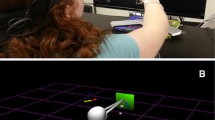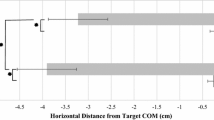Abstract
Most object manipulation tasks involve a series of actions demarcated by mechanical contact events, and gaze is typically directed to the locations of these events as the task unfolds. Here, we examined the timing of gaze shifts relative to hand movements in a task in which participants used a handle to contact sequentially five virtual objects located in a horizontal plane. This task was performed both with and without visual feedback of the handle position. We were primarily interested in whether gaze shifts, which in our task shifted from a given object to the next about 100 ms after contact, were predictive or triggered by tactile feedback related to contact. To examine this issue, we included occasional catch contacts where forces simulating contact between the handle and object were removed. In most cases, removing force did not alter the timing of gaze shifts irrespective of whether or not vision of handle position was present. However, in about 30% of the catch contacts, gaze shifts were delayed. This percentage corresponded to the fraction of contacts with force feedback in which gaze shifted more than 130 ms after contact. We conclude that gaze shifts are predictively controlled but timed so that the hand actions around the time of contact are captured in central vision. Furthermore, a mismatch between the expected and actual tactile information related to the contact can lead to a reorganization of gaze behavior for gaze shifts executed greater than 130 ms after a contact event.





Similar content being viewed by others
References
Akerfelt A, Colonius H, Diederich A (2006) Visual–tactile saccadic inhibition. Exp Brain Res 169:554–563
Ballard DH, Hayhoe MM, Li F, Whitehead SD (1992) Hand–eye coordination during sequential tasks. Philos Trans R Soc Lond B Biol Sci 337:331–339
Berkinblit MB, Fookson OI, Smetanin B, Adamovich SV, Poizner H (1995) The interaction of visual and proprioceptive inputs in pointing to actual and remembered targets. Exp Brain Res 107:326–330
Carlton LG (1981) Processing visual feedback information for movement control. J Exp Psychol Hum Percept Perform 7:1019–1030
Crawford JD, Medendorp WP, Marotta JJ (2004) Spatial transformations for eye–hand coordination. J Neurophysiol 92:10–19
Cuijpers RH, Smeets JB, Brenner E (2004) On the relation between object shape and grasping kinematics. J Neurophysiol 91:2598–2606
Desmurget M, Pelisson D, Rossetti Y, Prablanc C (1998) From eye to hand: planning goal-directed movements. Neurosci Biobehav Rev 22:761–788
Epelboim JL, Steinman RM, Kowler E, Edwards M, Pizlo Z, Erkelens CJ, Collewijn H (1995) The function of visual search and memory in sequential looking tasks. Vision Res 35:3401–3422
Flanagan JR, Johansson RS (2003) Action plans used in action observation. Nature 424:769–771
Flanagan JR, Bowman MC, Johansson RS (2006) Control strategies in object manipulation tasks. Curr Opin Neurobiol 16:650–659
Gordon AM, Forssberg H, Johansson RS, Westling G (1991) Integration of sensory information during the programming of precision grip: comments on the contributions of size cues. Exp Brain Res 85:226–229
Gribble PL, Everling S, Ford K, Mattar A (2002) Hand–eye coordination for rapid pointing movements: arm movement direction and distance are specified prior to saccade onset. Exp Brain Res 145:372–382
Groh JM, Sparks D (1996) Saccades to somatosensory targets. I. Behavioural characteristsics. J Neurophysiol 75:412–427
Hayhoe M, Ballard D (2005) Eye movements in natural behavior. Trends Cogn Sci 9:188–194
Jeannerod M (1988) The neural and behavioural organization of goal-directed movements, OUP Psychology Series No 5. Oxford, New York
Jenmalm P, Johansson RS (1997) Visual and somatosensory information about object shape control manipulative fingertip forces. J Neurosci 17:4486–4499
Jenmalm P, Dahlstedt S, Johansson RS (2000) Visual and tactile information about object curvature control fingertip forces and grasp kinematics in human dexterous manipulation. J Neurophysiol 84:2984–2997
Johansson RS, Birznieks I (2004) First spikes in ensembles of human tactile afferents code complex spatial fingertip events. Nat Neurosci 7:170–177
Johansson RS, Flanagan JR (2007)Tactile sensory control of object manipulation in humans. In: Kass JH, Gardner EP (eds) The senses: a comprehensive reference. Vol 6. Somatosensation. Elsevier, Oxford, pp 67–86
Johansson RS, Westling G (1984) Roles of glabrous skin receptors and sensorimotor memory in automatic-control of precision grip when lifting rougher or more slippery objects. Exp Brain Res 56:550–564
Johansson RS, Westling G (1988) Coordinated isometric muscle commands adequately and erroneously programmed for the weight during lifting task with precision grip. Exp Brain Res 71:59–71
Johansson RS, Westling G, Backstrom A, Flanagan JR (2001) Eye–hand coordination in object manipulation. J Neurosci 21:6917–6932
Kleinholdermann U, Brenner E, Franz VH, Smeets JB (2007) Grasping trapezoidal objects. Exp Brain Res 180:415–420
Land M, Mennie N, Rusted J (1999) The roles of vision and eye movements in the control of activities of daily living. Perception 28:1311–1328
Neggers SF, Bekkering H (2000) Ocular gaze is anchored to the target of an ongoing pointing movement. J Neurophysiol 83:639–651
Neggers SF, Bekkering H (2001) Gaze anchoring to a pointing target is present during the entire pointing movement and is driven by a non-visual signal. J Neurophysiol 86:961–970
Paillard J (1996) Fast and slow feedback loops for the visual correction of spatial errors in a pointing task: a reappraisal. Can J Physiol Pharmacol 74:401–417
Prablanc C, Martin O (1992) Automatic control during hand reaching at undetected two-dimensional target displacements. J Neurophysiol 67:455–469
Prablanc C, Echallier JF, Komilis E, Jeannerod M (1979) Optimal response of eye and hand motor systems in pointing at a visual target. I. Spatio-temporal characteristics of eye and hand movements and their relationships when varying the amount of visual information. Biol Cybern 35:113–124
Prablanc C, Pelisson D, Goodale MA (1986) Visual control of reaching movements without vision of the limb.1. Role of retinal feedback of target position in guiding the hand. Exp Brain Res 62:293–302
Prablanc C, Desmurget M, Grea H (2003) Neural control of on-line guidance of hand-reaching movements. Prog Brain Res 142:155–170
Sarlegna F, Blouin J, Vercher JL, Bresciani JP, Bourdin C, Gauthier GM (2004) Online control of the direction of rapid reaching movements. Exp Brain Res 157:468–471
Saunders JA, Knill DC (2004) Visual feedback control of hand movements. J Neurosci 24:3223–3234
Smeets JB, Brenner E (1999) A new view on grasping. Motor Control 3:237–271
Smeets JB, Brenner E (2001) Independent movements of the digits in grasping. Exp Brain Res 139:92–100
Wolpert DM, Flanagan JR (2001) Motor prediction. Curr Biol 11:R729–R732
Wolpert DM, Ghahramani Z (2000) Computational principles of movement neuroscience. Nat Neurosci 3(Suppl):1212–1217
Wolpert DM, Ghahramani Z, Flanagan JR (2001) Perspectives and problems in motor learning. Trends Cogn Sci 5:487–494
Acknowledgments
This work was supported by the Canadian Institutes of Health Research. MCB was supported by a scholarship from the Natural Sciences and Engineering Research Council of Canada. We thank Martin York for technical support.
Author information
Authors and Affiliations
Corresponding author
Additional information
An erratum to this article is available at http://dx.doi.org/10.1007/s00221-010-2526-6.
Rights and permissions
About this article
Cite this article
Bowman, M.C., Johannson, R.S. & Flanagan, J.R. Eye–hand coordination in a sequential target contact task. Exp Brain Res 195, 273–283 (2009). https://doi.org/10.1007/s00221-009-1781-x
Received:
Accepted:
Published:
Issue Date:
DOI: https://doi.org/10.1007/s00221-009-1781-x




